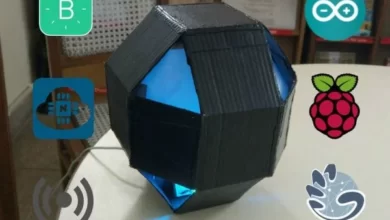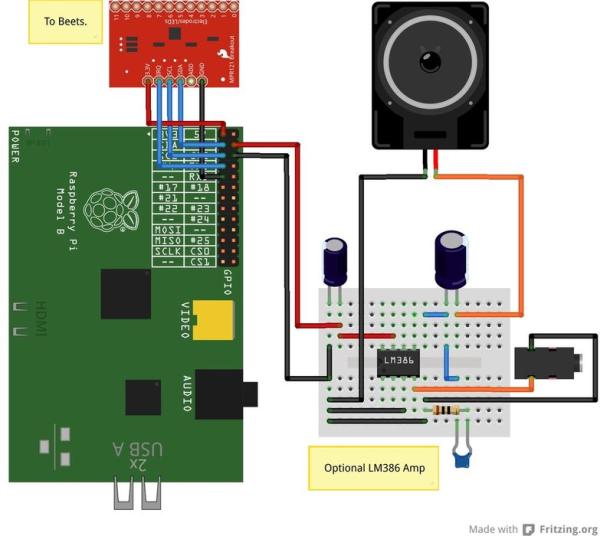Raspberry Pi Home Automation – Control Lights, Computers, CCTV and More!
Hey guys, first of all I’d like to introduce myself to everyone. My name is Jack, commonly known as Jackk or JackkTutorials over on YouTube where I do technology tutorials on home automation and control lights, but mainly cover Hacking & Security control, home automation and other useful things that you wouldn’t normally know about.
For this competition I decided I would make a completely universal Home Automation control panel using a Raspberry Pi 2, Relay Channels and some other cheap products. This is a very cheap home automation system!
For my example, the home automation controls my Desk LED’s, Bedside Lamp and Lava Lamp. It also displays the current time and current weather forecast for my area (Which I chose to remove in the picture because it shows my exact location). It can also switch my Media Center PC and Workstation PC on using a Wake on Lan feature. The camera section will also redirect to a live IP Camera feed from my old HTC One M7 with the IP Camera application on which runs 24/7. Under the miscellaneous sections was supposed to be an Alarm Clock which I could set a time for all the lights to turn on and an alarm sound to play through speakers, that’ll be sure to wake me up! But I never got round to implementing that part – but there’s no reason why it wouldn’t work!
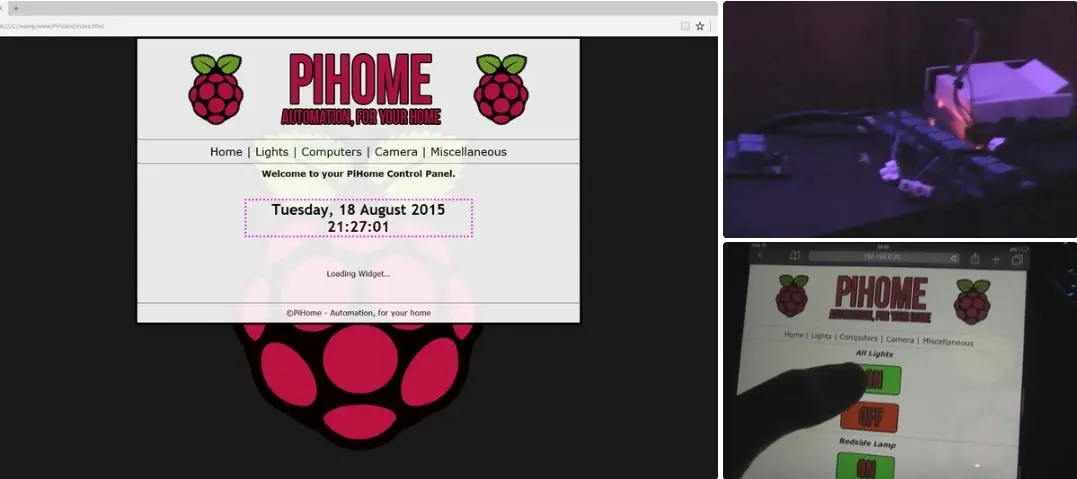
I’d like to mention that this project isn’t for the faint of heart and some basic knowledge electronics will help you such a Soldering, Wire Striping, GPIO and Relay Switches; however everything will be explained. Also remember that messing around with electricity that comes directly from your wall socket is very dangerous and can result in a serious injury so please be careful!
Also basic knowledge of Web Servers, Python, PHP and GPIO will help you out a lot!
Finally, I will only be showing you guys how to make one lamp turn on and off from a Web GUI. As everything else if very easy to setup. Such as the World Clock being a HTML Widget and the IP Camera being a hyperlink to a IP Server.
Anyway, lets get started!
Step 1: Tools We Will Need
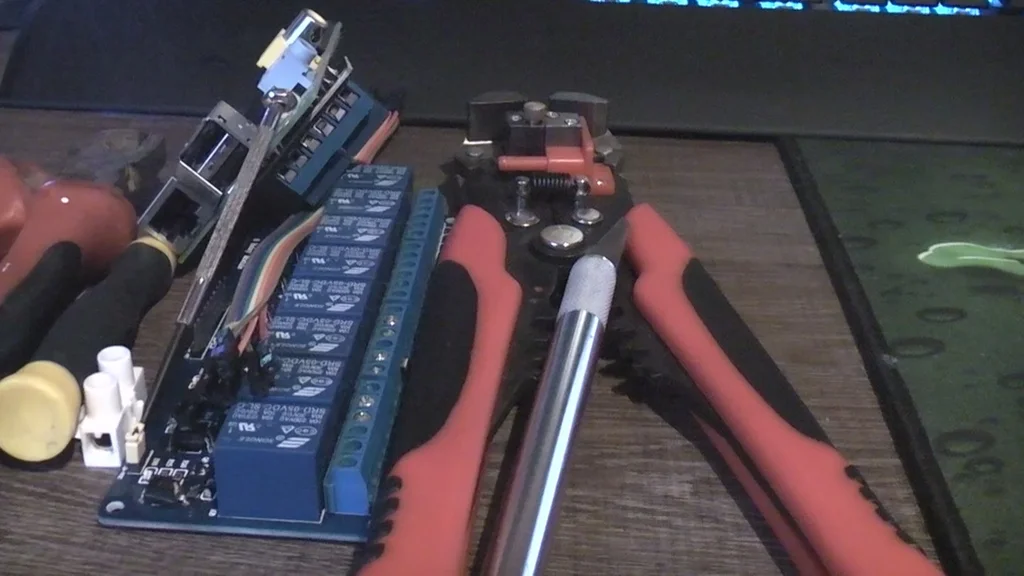
Time to talk about what we are going to need. For everyone’s convenience I have made links to both Amazon/eBAY UK and Amazon/eBAY US to help out my International readers. So below is a parts list with links to all the products.
Important Components
Raspberry Pi Model 2 – I’ll admit, you could use a Model B or B+ (Or maybe even A) but I’d just go all out and buy the best one on the market. For £30/$41 you have a tiny power house that you can use for this project and many more!
Amazon.co.uk – Link
Amazon.com – Link
Make sure you also pick up the SD Card (MicroSD), Power Supply and a case (Case not nessessory but will keep the Raspberry Pi safer!). Also the Raspberry Pi will need an internet connection for this project as the whole user interface is web-powered!
Relay Channel Module Boards – These relay switches are used only for the lights (In my example). They are what are going to be capable of switching things on or off from our Home Automation system. Now these come as modules that have so many relays. I personally bought an 8 Channel relay board for other future projects however you can get 1/2/4/8/16 so just pick which one you want. An 8 Channel relay board cost me £5.64 or $8.38 (Cheaper from China but longer shipping time!)
eBAY.co.uk – Link
eBAY.com – Link
If you want to buy a different size one, for example 2 channel or 4 channel just search “x channel relay module board” x being the number of channels you want. Each channel can control one function.
Raspberry Pi Jumper Cables – These are used to connect the Raspberry Pi to the Relay Module Board so we can communicate with it. They are very cheap, very reusable and come in a variety of different colours! They cost around £4 or $5 for around 40 of them. It also means we don’t need to solder!
eBAY.co.uk – Link
eBAY.com – Link
Additional Tools you may already have!
Now for tools most of us will already have lying around. I won’t bother posting purchase pages for these just because most of us have these tools at hand!
Philips/Crosshead Screwdriver (PH0/PH1 works best)
Flat Head Screwdriver
Wire Snippers
Wire Strippers
Craft Knife/Stanley Knife/Any Sharp Knife
Soldering Iron/Cable Crimps/Cable Blocks
Cable Flex (For extending our original wires to our lamps, ideal to keep everything in it’s original place, most lamps use 2 core flex)
That should be all the tools we need for this project!
Step 2: Software
I ain’t kidding when I say this is a large project. This is going to require an equal amount of effort in both hardware and software. So let’s talk about the software we are going to need for this project. I will put links to all the different softwares need and setting each software up will be an individual step as it can be quite complicated. So lets dive in!
Raspbian – We are going to need an operating system for our Raspberry Pi to run. For this I will be using Raspbian as it comes pre-installed with Python and is a piece of cake to set-up and use. We don’t need a pretty GUI however because we will just be using it’s command line interface
Download – Link
* Ignore these tools if you are using a Keyboard, Monitor and Mouse!
PuTTY * – We are going to need to be able to connect to our Raspberry Pi via SSH. So PuTTY is the perfect client to do this.
Download – Link
Nmap * – If you need to know what the IP Address of your Raspberry Pi is we are going to use Nmap to find it.
Download – Link
FileZilla – We are going to need a way to transfer files onto the Raspberry Pi using SFTP which is FTP over SSH. Usful stuff
Download – Link
Win32DiskImager – This will be used to burn Raspbian onto an SD Card for use in our Raspberry Pi
Download – Link
We will also need a Web Server for our Raspberry Pi but we will get that later because we will be using apt-get.
I won’t be showing how to install a Raspberry Pi because it’s super simple and I am assuming you guys know how to setup one because you are reading this guide. So let’s move on…
Step 3: Designing the GUI

This whole project is driven using a Web GUI I made. It’s super simple and uses mostly HTML with little bits of PHP too. Some basic HTML knowledge will help you with this because I won’t be showing you how I designed my website as this is a Raspberry Pi guide; not a web design guide. However I do have a video tutorial which is based on the same design I have used. You can watch in the video I have attached.
However you are going to need to create buttons. For example I made a “On” and “Off” image and linked that too a page which makes a nice big button. I’ll talk later in a few steps about setting these buttons up to make lights turn on and off.
If you’re interested, the image sizes are 200×100.
When you design your website make sure that your extensions are *.php and not *.html just to keep things all the same. However we are only going to be using two PHP files for one light.
Once you’ve designed your website and it looks the way you want too, we can move onto the next step. The next step is hardware so bare that in mind.
Step 4: Wiring Up the Lamp, Relay Connectors and Raspberry Pi.

The first image shows you how to wire up your Raspberry Pi to the 8 Channel Relay board using the Jumper cables. I recommend using Red for Positive and Black for Negative just to keep things simple.
Now that you’ve wired this up we can prepare our lamp. Please refer to the diagram featuring the lamp. I apologize for my crude designs, but hopefully they make sense. Please read the step by step instructions incase you are confused.
1. Cut the flex cable in half using Wire cutters and then strip back the insulation.
2. You will have two wires inside the flex – Blue(Neutral) and Brown(Live) (In most cases). Strip back the insulation on both of these wires and twist the ends up to make a neat end.
3. Connect the two blue ends of the wire together using a connector block or solder. Connect the brown wire to the relay channel using the middle and left side of one relay switch. Fasten this down with the screw and make sure it’s secure. Ensure that the wires cannot short out.
Take a look at the final diagram to make sure you have everything setup correctly.
Now let’s move onto testing our creation so far. Once we know it works we can start making it work via the web.
Step 5: Testing Our Lamp With the Relay Channel
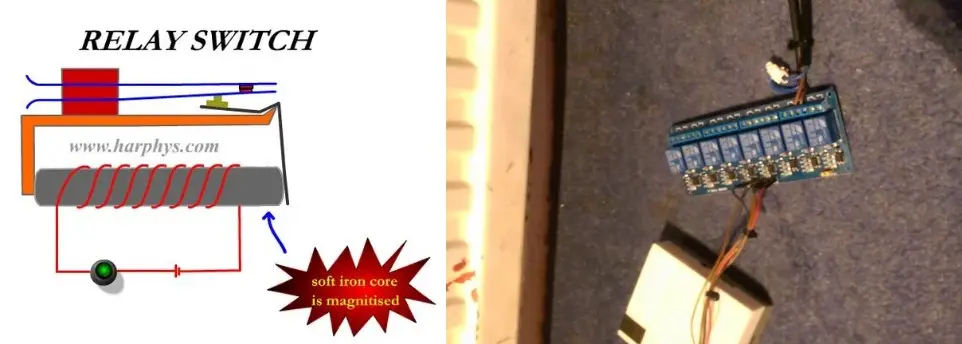
So the way this works is very simple. Hopefully you guys will know what a Relay Switch is, but in case you don’t I’ll explain it anyway.
The Relay Switch works how a switch normally works, however it operates using an electrical source (The raspberry pi). Our raspberry pi cannot turn the lamp on by itself, so we use a relay switch to simple break the circuit when we want the lamp off and then connect the circuit when we want it in. This is controlled by an electrical magnet in the relay switch. You will hear a distinctive click when the relay switch is opened or closed. You can refer to the diagram for a visual representation of a relay switch.
I have included a picture of what my raspberry pi looked like when I had connected up the lamp, relay board and raspberry pi. Now lets test it!
Plug in your raspberry pi to a mouse, keyboard and monitor or use NMAP and PuTTY. Ensure that Python is installed as Python will be half of the scripting language we will be using. Open up Python and we can type in commands to make the lamp turn on and off. I will be using my windows machine for screenshots, however it is the same on the raspberry pi.
In the Raspberry Pi command line you will want to type in these commands, pressing <ENTER> after each one.
import RPi.GPIO as GPIO //This imports the GPIO Library into Python so we can use the GPIO Pins on the Pi.
GPIO.setmode(GPIO.BCM)
GPIO.setup(2, GPIO.OUT) //We are using GPIO 2 as our first pin, which is where the green wire is connected to the first relay switch on the baord
GPIO.output(2, False) //Depending on how you wired the lamp to the relay will depend whether the this command will turn the lamp on or off. Changing False to True will turn the lamp off/on. If this works, then you are ready to continue. If you have problems read on:
Troubleshooting
When you type GPIO.output(2, False/True) you should hear a distinctive clicking noise coming from the relay channel, if you do not hear this then make sure that your relay board has power (From the raspberry pi) and that the wire going from the first channel is connected to GPIO Pin 2.
If you hear the clicking noise but the lamp does not turn on with either GPIO.output(2, False) or GPIO.output(2, True) then make sure that you have the wires from the lamp in the right sockets on the relay channel.
Step 6: Adding Web Functionality
By now you should have a website that you can transfer over to the Raspberry Pi. Watch the video by gigafide to learn how to turn your Raspberry Pi into a webserver so it can host our Web GUI. Once you’ve done that and you have verified that you can view your website on another computer we can move onto making the website turn on our lamp.
Inside your website directory create a new php file called “lampon.php” and inside put in this code:
<?php
system(“echo raspberry | sudo -S python /var/www/PiHome/scripts/lights/lampon.py“); header( ‘Location: ‘<page>.php‘ ) ;
?>
This will execute a script called lampon.py which we will create in a second. Make sure your that your file path (In bold) is the same. Also in bold I have entered a location for where the page will direct when the script runs, set this as your homepage or the lights page – your choice. Save this file.
Now create a folder in the website directory called “scripts” and inside there create another folder called “lights” and then inside there create a new file called “lampon.py” – This will be the python script that turns our lamp on. Inside there enter this code:
import RPi.GPIO as GPIO
GPIO.setmode(GPIO.BCM)
GPIO.setup(2, GPIO.OUT)
GPIO.output(2, False)
And save it.
Now go back to your website design and make sure the hyperlink for your “On” button links to “lampon.php”. Now when you click the button the lampon.php script will execute the lampon.py python script resulting in the lamp turning on. Now we can make it turn off.
Inside the website directory create a new file called lampoff.php. Inside this file enter this code:
<?php
system(“echo raspberry | sudo -S python /var/www/PiHome/scripts/lights/lampoff.py“); header( ‘Location: ‘ <page>.php’ ) ;
?>
Again, make sure your file path is the same so that this works. Also set your redirection to redirect to the page of your choice.
Now make a new file in the scripts\lights\ folder called lampoff.py. Inside this file enter this code:
import RPi.GPIO as GPIO
GPIO.setmode(GPIO.BCM)
GPIO.setup(2, GPIO.OUT)
GPIO.output(2, True)
Save this file.
Now hyperlink lampoff.php to your “Off” button. This should make your lamp turn off. If is the right way, swap the scripts around and it should work perfectly.
You now have a Website that can control your lights! The next step will be the conclusion.
?>
Step 7: Conclusion
So that’s it guys! Controlling lights from your raspberry pi. I really liked this project and had fun working on it. If this guide seems a bit rushed it’s because there is only 7 days left of the competition and I am super busy. I wish I had some video footage of this project however I had to dismantle the system after a week because my girlfriend kept complaining about it.
It’s a great start in learning how you can control things like lights using a website. You can easily add more lights onto this and also add other neat things like an alarm clock. I had a button that switched all my lights on and off at the click of a button. It was awesome!
You can really go wild with this, I’ve just given you the baby steps.
If you have any problems or questions then feel free to contact me:
www.jackktutorials.com/contact
I have loads of different ways you can contact me – but I recommend emailing me.
Well that’s it. I’ll be ecstatic if I win this competition, but thanks guys! I hope you enjoyed my first Instructables.
Source: Raspberry Pi Home Automation – Control Lights, Computers, CCTV and More!

